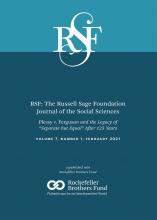Research Article
Open Access
Plessy’s Legacy: The Government’s Role in the Development and Perpetuation of Segregated Neighborhoods
Leland Ware
RSF: The Russell Sage Foundation Journal of the Social Sciences February 2021, 7 (1) 92-109; DOI: https://doi.org/10.7758/RSF.2021.7.1.06
Leland Ware
aRedding Professor for the Study of Law and Public Policy at the University of Delaware, United States

REFERENCES
- ↵
- Anderson, Martin
- ↵
- Austin, Margery,
- Susan J. Popkin, and
- Lynette A. Rawlings
- ↵
- Badger, Emily, and
- Darla Cameron
- ↵
- ↵
- Baldwin, James
- ↵
- Benbow, Mark E
- ↵
- ↵
- ↵
- Brescia, Raymond H
- ↵
- Caro, Robert A
- ↵
- Cottrol, Robert J.,
- Raymond T. Diamond, and
- Leland B. Ware
- ↵
- DiMento, Joseph F. C., and
- Cliff Ellis
- Federal Housing Administration
- ↵
- Editorial Board
- ↵
- Fisher, Linda E
- ↵
- Fishman, Robert
- ↵
- Fox, Kenneth
- ↵
- Foxx, Anthony
- ↵
- Freund, David M. P
- ↵
- Galster, George, and
- Erin Godfrey
- ↵
- Gee, Gilbert C., and
- Chandra L. Ford
- ↵
- Gordon, Adam
- ↵
- Gotham, Kevin Fox
- ↵
- Greenberg, Jack
- ↵
- Hanks, Angela,
- Danyelle Solomon, and
- Christian E. Weller
- ↵
- Hauser, Susan E
- ↵
- Hoffer, Williamjames Hull
- ↵
- Howell, Benjamin
- ↵
- Hoyt, Homer
- ↵
- Husain, Asma
- ↵
- Jackson, Kenneth T
- ↵
- Kluger, Richard
- ↵
- Lee, Timothy B
- ↵
- Lemann, Nicholas
- ↵
- Litwack, Leon F
- ↵
- Loewen, James
- ↵
- Lamb, Charles M.,
- Randolph S. Kent,
- Jacqueline M. Sievert,
- Michael R. Staszkiw, and
- Elizabeth A. Tillman
- ↵
- Massey, Douglas S., and
- Nancy A. Denton
- ↵
- Massey, Douglas S.,
- Len Albright,
- Rebecca Casciano, and
- Elizabeth Derickson
- ↵
- Myrdal, Gunnar
- ↵
- Nelson, Robert K.,
- LeDale Winling,
- Richard Marciano,
- Nathan Connolly, et al
- ↵
- Oliver, Melvin L., and
- Thomas M. Shapiro
- ↵
- Oliver, Melvin L., and
- Thomas M. Shapiro
- ↵
- Pomerantz, Gary
- ↵
- Power, Garrett
- ↵
- Price, Alfred D
- ↵
- Pritchett, Wendell E
- ↵
- Relman, John P
- ↵
- Rothstein, Richard
- ↵
- Ruechel, Frank
- ↵
- Rugh, Jacob S., and
- Douglas S. Massey
- ↵
- Schulz, Amy J.,
- David R. Williams,
- Barbara A. Israel, and
- Lora Bex Lempert
- ↵
- Squires, Gregory D
- ↵
- ↵
- Suddath, Claire A
- ↵
- Taylor, Keeanga-Yamahtta
- ↵
- ↵
- Teitelbaum, Joel, and
- Ellen Lawton
- ↵
- Ware, Leland
- ↵
- Ware, Leland
- ↵
- Ware, Leland, , and
- Theodore Davis
- ↵
- Weaver, Robert
- ↵
- Weimer, Arthur M., and
- Homer Hoyt
- ↵
- Wilkerson, Isabel
- ↵
- ↵
- Williams, David R., and
- Pamela Braboy Jackson
- ↵
- Williams, David R., and
- Chiquita Collins
- ↵
- Williams, David R., and
- Michelle Sternthal
- ↵
- Woodward, C. Vann
- ↵
- Yellin, Eric S
In this issue
Plessy’s Legacy: The Government’s Role in the Development and Perpetuation of Segregated Neighborhoods
Leland Ware
RSF: The Russell Sage Foundation Journal of the Social Sciences Feb 2021, 7 (1) 92-109; DOI: 10.7758/RSF.2021.7.1.06
Jump to section
- Article
- Abstract
- SEPARATE AND UNEQUAL
- PLESSY AND THE BETRAYAL OF RECONSTRUCTION
- THE SPREAD OF SEGREGATION
- THE GREAT MIGRATION AND SUBURBANIZATION
- REVERSE REDLINING AND GHETTO LOANS
- SEPARATE NEIGHBORHOODS PERPETUATE SEGREGATED SCHOOLS
- URBAN RENEWAL AND “NEGRO REMOVAL”
- THE INTERSTATE HIGHWAY SYSTEM
- EXCLUSIONARY ZONING
- SEGREGATION AND THE SOCIAL DETERMINANTS OF HEALTH
- CONCLUSION
- FOOTNOTES
- REFERENCES
- Info & Metrics
- References
Related Articles
- No related articles found.
Cited By...
- No citing articles found.





